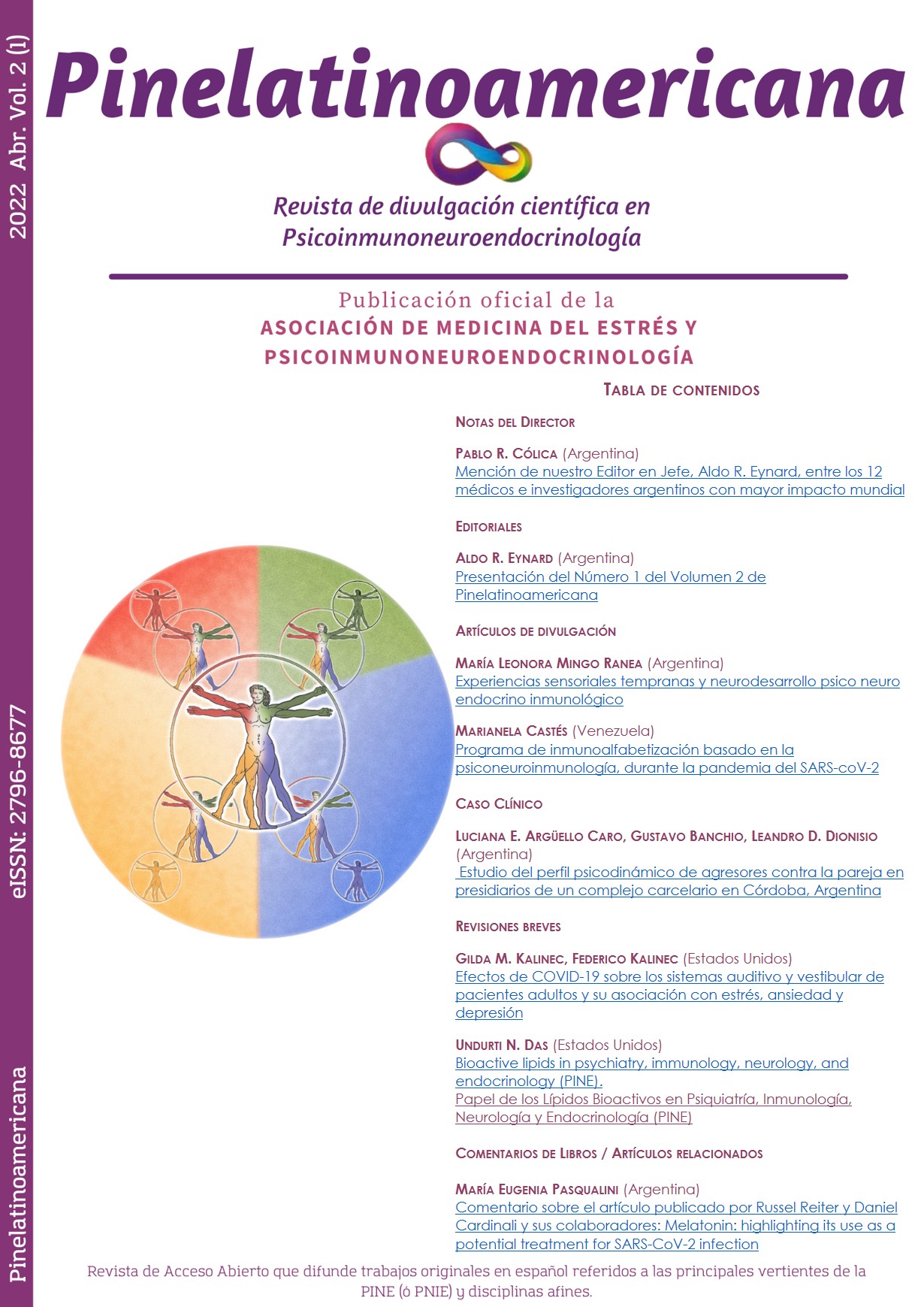Abstract
Early sensory experiences, since earlier intra-uterine life have a great influence on the neurodevelopment, structuring and functionality of psycho, neuro and endocrine-immunological processes (PINE). The unique PINE characteristics will accompany the whole life of the subject making it particular in the way of capturing internal and external stimuli and processing, adapting them useful for learning in the life. The way in which the different sensations are integrated, perceived, compared and stored in memory will allow the subject to assemble her/his internal and external world making it unique in the ways of being and doing.
References
Abelenda, A. J., y Rodríguez Armendariz, E. (2020). Evidencia científica de integración sensorial como abordaje de terapia ocupacional en autismo [Scientific evidence of sensory integration as an approach to occupational therapy in autism]. Medicina, 80 Suppl 2, 41–46. https://www.medicinabuenosaires.com/indices-de-2020/volumen-80-ano-2020-s-2-indice/evidencia/
Acosta, G. B. y Manzanares Robles J. (2020). Neurobiología del estrés temprano: Respuesta del estrés durante la programación de la vida temprana. 2020 Editorial Sciens. https://biblioteca.sciens.com.ar/gb-acosta-j-manzanares-robles-neurobiologia-del-estres-temprano/64059915
Álvarez Martínez, E. (2021). El apego desde el Útero. Revista digital de medicina psicosomática y psicoterapia, 11 (2),1-8. https://www.psicociencias.org/pdf_noticias/El_apego_desde_el_utero_E.Alvarez.pdf.
Ayres, J. A y Robins, J. (2008). La integración sensorial en los niños: Desafíos sensoriales ocultos. Editorial Tea.
Cáceres R., Martínez-Aguayo, J. C., Arancibia M. y Sepúlveda E. (2017). Efectos neurobiológicos del estrés prenatal sobre el nuevo ser. Revista chilena de neuropsiquiatría, 55(2), 103-113. https://dx.doi.org/10.4067/S0717-92272017000200005.
Cólica, P. R. (2021). Conductas emocionales y estrés. Pinelatinoamericana, 1(1), 12–17. https://revistas.unc.edu.ar/index.php/pinelatam/article/view/36036
Dixon, S. D., Yogman, M., Tronick, E., Adamson, L., Als, H. y Brazelton, T. B. (1981). Early infant social interaction with parents and strangers. Journal of the American Academy of Child Psychiatry, 20(1), 32–52. https://doi.org/10.1016/s0002-7138(09)60715-9
Flores-Compadre, J. L., Cruz, F., Orozco, G. y Vélez, A. (2013). Hipoxia perinatal y su impacto en el neurodesarrollo. Revista Chilena de Neuropsicología, 8(1), 26-31. https://www.redalyc.org/articulo.oa?id=179328394005
Fontein-Kuipers, Y. J., Nieuwenhuijze, M. J., Ausems, M., Budé, L., y de Vries, R. (2014). Antenatal interventions to reduce maternal distress: a systematic review and meta-analysis of randomised trials. BJOG: an international journal of obstetrics and gynaecology, 121(4), 389–397. https://doi.org/10.1111/1471-0528.12500
Food Green Mood. (2014). Sabores desde el útero. Marta León García, www.foodgreenmood.com. https://foodgreenmood.com/2014/04/23/sabores-desde-el-utero/
Glover, V. (2014). Maternal depression, anxiety and stress during pregnancy and child outcome; what needs to be done. Best practice & research. Clinical obstetrics & gynaecology, 28(1), 25–35. https://doi.org/10.1016/j.bpobgyn.2013.08.017
González-Islas, C. y García-Bereguiain, M. A. (2019). La actividad embrionaria espontánea de las redes neuronales y su función en la maduración sináptica. Rev. Ecuat. Neurol., 28(1), 56-62. http://scielo.senescyt.gob.ec/scielo.php?script=sci_arttext&pid=S2631-25812019000100056&lng=es&tlng=es.
Granda, M. (2017). Holding, el contacto con el bebe deja huella, no hacerlo también. Mi saquito mágico. https://misaquitomagico.es/holding-contacto-bebe-huella/
Hervada, N. (2008). La Química del Apego. Mimos y teta. https://mimosytetablog.com/quimica-apego/
Kladko, B. (2017). Holding infants, or not, can leave traces on their genes. NeuroscienceNews.com. https://neurosciencenews.com/genetics-holding-babies-8033/.
Moore, S., McEwen, L., Quirt, J., Morin, A., Mah, S., Barr, R., Boyce, T. y Kobor, M. (2017). Epigenetic correlates of neonatal contact in humans. Development and Psychopathology, 29(5), 1517-1538. https://doi.org/10.1017/S0954579417001213.
Olza, I., Fernández Lorenzo P., González Uriarte, A., Herrero Azorín, F., Carmona Cañabate, S., Gil Sanchez, A., Amado Gómez, E. y Dip, M. E. (2021). Propuesta de un modelo ecosistémico para la atención integral a la salud mental perinatal. Revista Asociación Española Neuropsiquiatría. 41(139),23-35. https://www.revistaaen.es/index.php/aen/article/view/17146
Orschanski, E. (2021). La gestación humana bajo el enfoque de la Pediatría amplia. Pinelatinoamericana, 1(1), 18–25. https://revistas.unc.edu.ar/index.php/pinelatam/article/view/36156
Paredes, M. F., James, D., Gil-Perotin, S., Kim, H., Cotter, J. A., Ng, C., Sandoval, K., Rowitch, D. H., Xu, D., McQuillen, P. S., Garcia-Verdugo, J. M., Huang, E. J., y Alvarez-Buylla, A. (2016). Extensive migration of young neurons into the infant human frontal lobe. Science (New York, N.Y.), 354(6308), aaf7073. https://doi.org/10.1126/science.aaf7073.
Pooh Ritsuko, K. y Kurjak, A. (2011) Neurología fetal. Amolca.
Schwartz Baruj, C. (2021). Modelo cognitivo de procesamiento de la información. Comprendiendo los procesos PINE de la cognición. Pinelatinoamericana, 1(1), 39–48. https://revistas.unc.edu.ar/index.php/pinelatam/article/view/36231
Tellechea, M. L. (2020). La programación fetal y su impacto en la salud del adulto. Comunicación de la ciencia: CEDIE y sociedad. https://cedie.conicet.gov.ar/programacion-fetal/

This work is licensed under a Creative Commons Attribution-NonCommercial 4.0 International License.
Copyright (c) 2022 Pinelatinoamericana

